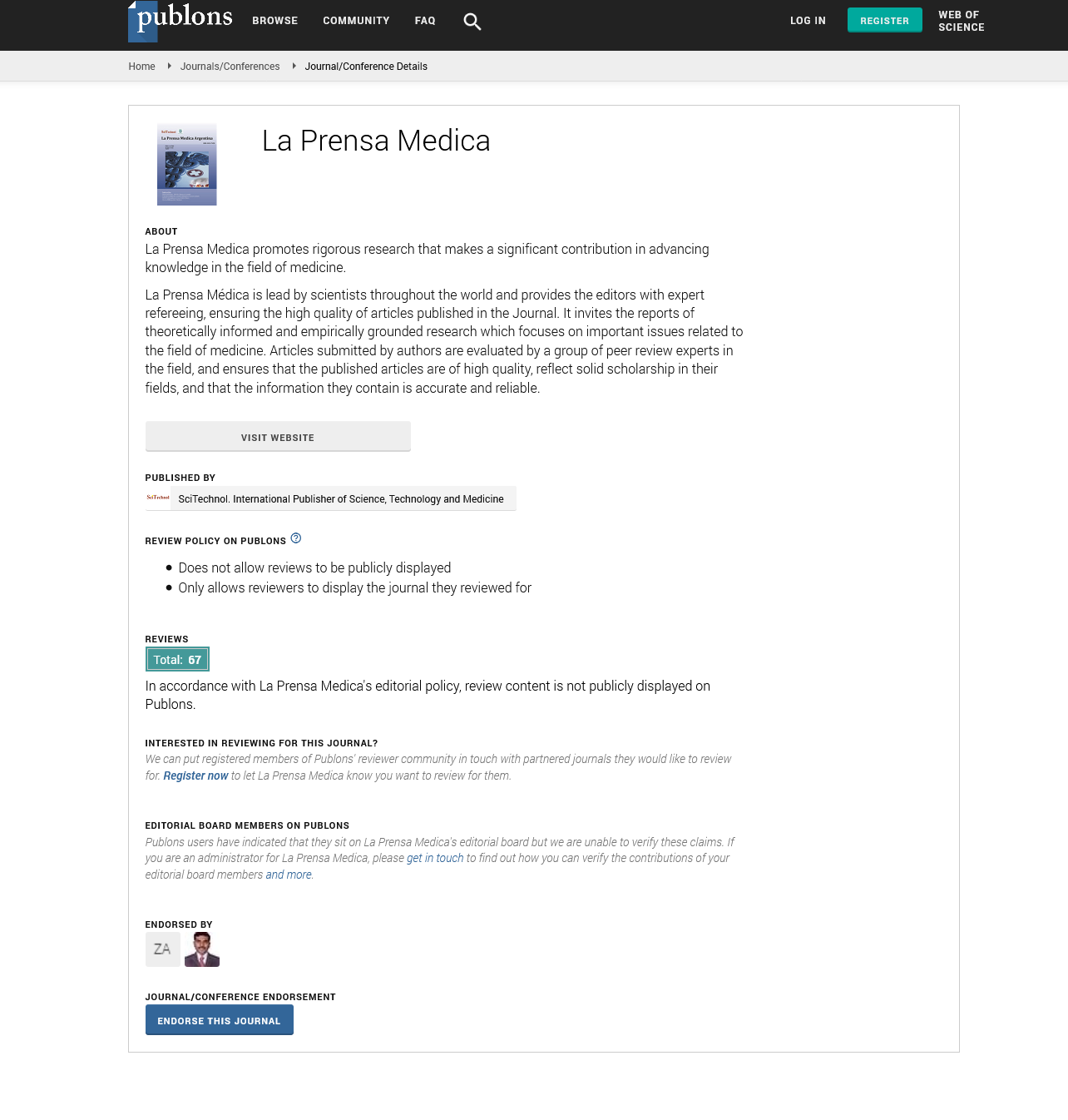Commentary, La Prensa Medica Vol: 108 Issue: 1
Surgical Treatment of Temporomandibular Joint Diseases Requires Set of Diagnostic Criteria
Shunji Takahashi *
Department of Genomic Medicine, University Medical Center Mannheim, Paris, France
Corresponding Author: Shunji Takahashi
Department of Genomic Medicine, University Medical Center Mannheim, Paris, France
E-mail:ShunjiTakahashi.edu.cn
Received date:03 January, 2022, Manuscript No. LPM-22-57660;
Editor assigned date: 05 January, 2022, PreQC No. LPM-22-57660 (PQ);
Reviewed date: 19 January, 2022, QC No LPM-22-57660;
Revised date: 24 January, 2022, Manuscript No. LPM-22-57660 (R)
Published date: 29 January, 2022, DOI: 10.4172/0032-745X.1000126
Citation: Takahashi S (2022) Surgical treatment of temporomandibular joint diseases requires a set of diagnostic criteria. La Prensa Medica 108:1.
Keywords: Prenatal yogaPhysiotherapy, Integrative yoga therapy, Geriatric yoga therapy, Aerodynamics, Yoga for athletes, teens and children
Description
Aging is a natural process which you cannot escape, the fact that probably you are getting older, for many women the years between after 50 brings a number of changes, successes achievements and challenges with memories. Some aspects in life after 50 of women can be controlled and some are out of our hands, along with health issues the risk of many chronic health issues increase with age, but there are several things which we can do to help lower your health risks. It is important to take care of physical, mental & emotional health. My presentation will be to improve women's health after the age of 50 by avoiding hormones replacement therapy that is estrogen and progesterone. After this age I feel that women are not answerable to any one, as by this age women have fulfilled all duties towards their family and should enjoy and make full use of their life. At the beginning of the twentieth century, life expectancy for women was just over 50 years. Now, thanks to advances in health care, as this century begins women can expect to live, on average, nearly 80 years, and in all likelihood, this life expectancy will increase in the near future.
Temporomandibular Joint
 Consequently, women will spend at least one third of their lives in the postmenopausal years and it has become a challenge for medicine and society to make these years as productive and free of morbidity as possible. Women of all ages should be encouraged to exercise. Even if they suffer from chronic illness, exercise may improve symptoms or even arrest the condition. There are three types of exercises in which women should be encouraged to participate. They are endurance, resistance, and balance training. Endurance training improves the cardiovascular status. This status depends upon cardiac output, which is heart rate � stroke volume, and the ability of muscles to extract oxygen. Cardiovascular endurance decreases with age at a rate of approximately oxygen per kilogram of body weight per year. Maximum heart rate decreases with age at a rate of about one heartbeat per year. While the decrease in heart rate is usually not changed by physical conditioning, cardiovascular endurance is. Muscle mass also decreases with age even in very active individuals, but is more marked in sedentary people. The weight-bearing type has an additional beneficial effect on bone mass, but may have a negative effect on problems involving the hip, knee, or ankle. Thus, the type of the endurance exercise should depend on the patient's general health and condition and what she is capable of doing. It has been shown that endurance training can improve cardiovascular conditioning by as much as 10% to 30% depending on how hard the individual exercises and the number of muscle groups involved in the exercise. The American College of Sports Medicine recommends that individuals get 30 minutes cumulative exercise per day at least 3 days per week. Weight-bearing exercises include walking, jogging, stair-climbing, cross-country skiing, and aerobic dance. Non- weight bearing exercises include swimming, rowing, and upper-body exercises. Endurance training improves cardiovascular condition and generally gives the individual greater energy.
Static Exercises
The goal of resistance training is improved muscle mass. Muscles are composed of two types of muscle fibres: slow twitch and fast twitch. Fast-twitch fibres account for rapid and powerful movements, and with age fast-twitch fibres tend to decrease in number, whereas slow-twitch fibres remain relatively stable. Weightlifting exercises help increase the number of fast-twitch fibres and the size of the muscle, thereby increasing muscle strength. Exercises utilizing weights can be performed by individuals of all ages and conditions, and should be done, at least at the start, under the direction of a personal trainer. This service may be obtained in any number of ways, including the YWCA, health clubs, or private practitioners. Posture and balance training is important for the elderly because it may decrease the tendency to fall. It will also improve posture. It integrates the sensory and motor systems and helps the individual to react more quickly to changes in the environment. Balance training can be separated into static and dynamic components. Static exercises include balancing the centre of gravity or standing in the same spot. The exercises may begin on a wide base, but then are performed on progressively narrower bases going gradually from a double-leg support to a semi tandem, to a tandem, to a single-leg support, and finally to static support on toes. Exercises may be sit-to-stand or cervical spine rotation or twist, side bending, and scapular retraction and elevation. Dynamic balance is maintaining the balance during movements and can be made progressively more difficult by narrowing the base of support and using side steps, crossover steps, forward or backward steps, high steps, heel-to-toe walking, and toe tapping. Aerobic dance can be useful in carrying out such exercises.
 Spanish
Spanish  Chinese
Chinese  Russian
Russian  German
German  French
French  Japanese
Japanese  Portuguese
Portuguese  Hindi
Hindi 

